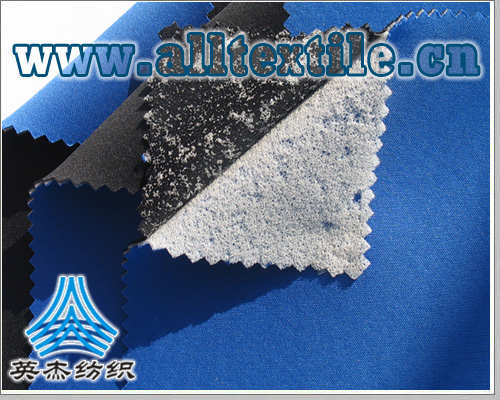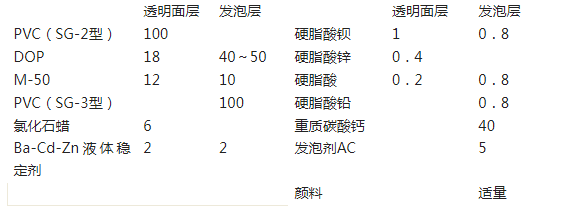PVC soft product formula and production process examples
PVC soft product formula and production process examples

1. Calendering wallpaper
The wallpaper produced by the calendering method has lower cost, higher mechanical strength and better scrub resistance, and is suitable for the production of medium and low-end wallpapers.
1. Product structure and production process: Calendered wallpaper is generally composed of a single layer of soft PVC film and a paper base, and its structure is relatively simple. The wallpaper can be decorated with prints or made into foam products.
Its basic production process is as follows:
Paper base
Ingredients → kneading → kneading → internal mixing → calendering → compounding → cooling → winding
2. Formula and production process The basic formula of non-foaming wallpaper is as follows:
PVC 100 Calcium Carbonate 50
DOP 20 Stearic acid 0.2
DBP 10 Stabilizer 3
Alkylsulfonate phenyl ester 30 Color paste Appropriate amount
In the formula, the PVC resin can be SG3 type, and the stabilizers can be barium stearate, cadmium stearate, and zinc stearate. The color paste is determined according to the color requirements of the product.
Calendering can also be used to produce foam wallpaper. The formula of foam wallpaper is as follows:
PVC 100 Ba-Cd-Zn liquid stabilizer 2
DOP 20 Barium stearate 0.6
DBP 10 Cadmium Stearate 0.6
Alkyl phenyl sulfonate 30 Zinc oxide 0.3~0.5
Calcium carbonate 50 AC foaming agent 3~5
Stearic acid 0.5 Color paste Appropriate amount
In the production process of foam wallpaper, a foaming process needs to be added. The calendered wallpaper semi-finished product is foamed in a tunnel oven. When using the calendering method to produce foam wallpaper, care should be taken to prevent the foaming agent from decomposing in advance during the calendering process. In order to prevent the foaming agent from decomposing prematurely, the plasticizing temperature (i.e. roller temperature) during the calendering process should be appropriately reduced. In the formula, the degree of polymerization of PVC resin should be appropriately reduced, and SG-4 resin can be used. The dosage of zinc oxide, the assistant foaming agent, should not be too much.
To make wallpaper more decorative, it is often printed and embossed. Printing can use a gravure printing machine, usually 3 to 6 colors. The printed wallpaper is preheated and the pattern is pressed by an embossing roller. You can also use the “ditch bottom printing method”. The groove bottom printing method is to set up a set of inking rollers next to the embossing roller, apply ink on the convex parts of the embossing roller, and print the pattern into the “groove bottom” while embossing, that is, embossing and printing are completed at the same time. .
2. Composite floor leather
1. Product structure and production process: Calendering method is used to produce non-foaming composite floor leather. The product is composed of a base layer and a surface decorative film. The base layer is a highly filled semi-rigid rolled material, which has low cost. The surface decorative film is PVC printed film. By changing the printing pattern, products of various colors can be produced. After the base layer is calendered and formed, it is compounded with the decorative film on a three-roller laminating machine and calendered or embossed. The basic production process flow is as follows:
Ingredients→Kneading→Mixing→Opening→Calendering
↓
Surface decorative film→three-roller composite calendering→cooling→coiling
2. Formula and production process The formula of the base layer of composite floor leather is as follows:
PVC 100 Lubricant 1~1.5
Plasticizer 25~40 Calcium carbonate 80~120
stabilizer 3~4
In the formula, PVC can be selected from SG-5 or SG-6 type. The main plasticizer is DOP, and a small amount of auxiliary plasticizer can also be added. Stabilizers can be barium stearate, cadmium, zinc, etc., and lubricants can be stearic acid, etc. Calcium carbonate should be treated with a coupling agent.
The surface decorative film is a calendered printing film with a thickness of generally 0.15mm. In order to improve the pollution resistance of the surface, the plasticizer in the decorative film should not be too much, and plasticizers that are easy to migrate such as DBP should not be used.
3. Calendering chemically embossed floor leather
Calendering method chemically embossed floor leather is a kind of foamed floor leather, which uses a foaming suppression method to form an embossed-like pattern, so it is called chemically embossed floor leather. Compared with non-foamed floor leather, foamed floor leather has the advantages of softness, comfort and elasticity, so it is also called PVC elastic coiled flooring. Foam flooring also has the advantages of sound insulation, heat preservation, and easy paving. Compared with carpets, it has the advantage of being easy to clean. Chemical embossing makes foam floor leather more decorative and improves anti-slip properties.
1. Product structure Calendered chemically embossed floor leather is made by a multi-layer composite method. Its product structure consists of a transparent surface layer, a foam layer and a base material.
2. Chemical embossing principle and printing ink formula The basic principle of the chemical embossing method is to add a foaming inhibitor to the printing ink, and the ink is printed on the PVC foaming layer, which suppresses the foaming process of the printed ink part and causes The foaming ratio is reduced. For the parts that are not printed with ink (containing inhibitors), foaming is not affected and the magnification is high, thus forming a three-dimensional pattern similar to an embossing effect. Foaming inhibitors added to printing inks generally use organic acids, such as trimesic acid, fumaric acid, itaconic acid, etc. The basic formula of inhibitor-containing ink is as follows:
Vinyl chloride-vinyl acetate copolymer 100 Foaming inhibitor 100~150
Solvent 500~700 Pigment, Stabilizer Appropriate amount
Among them, the solvents are cyclohexanone, ethyl acetate, butanone, etc.
The chemical embossing method can also add a foaming accelerator to the printing ink, which is called the foaming accelerator method.
3. Production process flow and formula The production process flow of chemically embossed floor leather by calendering method is as follows:
Ingredients, kneading, and plasticizing
↓
Substrate treatment→Four-roller calendering, lamination of foam layer→Printing of inhibitor-containing ink→
Composite transparent surface layer→foaming (chemical embossing)→cooling→winding
Among them, gravure printing machine is used for printing. The transparent surface layer is composited on a three-roller laminating machine. Foaming is completed in a channel oven, and the foaming ratio is about 2 times.
The basic formula of calendering chemically embossed floor leather is as follows:

Pigments
Appropriate amount
In the formula, the amount of plasticizer in the surface layer is less to prevent the surface layer from becoming sticky and improve its anti-pollution properties. The foaming layer has a larger amount of plasticizer, which can make the product softer.
4. Hairdryer leather for coal mines
1. Product structure and process flow Coal mine air ducts are made of materials for underground air ducts and must have flame retardant and antistatic properties. There are three types of hairdryer leather: rubber type, rubber-plastic type, and plastic type. Among them, the plastic type is made of flame-retardant soft PVC material. Its product structure is based on fabric as the skeleton, and is rolled on both sides to form a double-sided coated soft PVC film layer. Here we introduce the double-sided calendering method.
The production process of double-sided calendering method for making hairdryer leather is similar to that of ordinary artificial leather by calendering method, but it needs to be calendered twice. The first pass is calendering to compound one mask layer, and the second pass is calendering to compound the other mask layer. The basic process flow is as follows:
Base fabric treatment
↓
Ingredients→kneading→plasticizing→first calendering→compounding→semi-finished products
Second calendering→compositing→finished product
2. Formula As the fabric of the skeleton material, you can choose fiberglass/cotton interwoven fabric or high-strength polyester lattice fabric. The formula of the PVC film layer must have flame retardant and antistatic properties, and must take into account mechanical properties, weather resistance, cold resistance, etc. The basic formula is as follows:
PVC 100 Antistatic agent 3~5
Plasticizer 50~55 Filler 10~20
Stabilizer 3~5 Other auxiliaries 2~5
Flame retardant 5~10
In the formula, PVC resin can be selected from SG-2 or SG-3 type. The plasticizer is mainly DOP, DOS is added to improve cold resistance, and some low-volatile plasticizers are added to improve cold resistance. The antistatic agent can be a non-ionic antistatic agent, supplemented by conductive carbon black. Fillers can be calcium carbonate or wollastonite. Stabilizers include barium stearate, lead stearate, etc. The vinyl retardant is mainly antimony trioxide, supplemented by flame retardant plasticizers such as chlorinated paraffin. In addition, an appropriate amount of lubricant, such as stearic acid, and an appropriate amount of pigment need to be added.
With conductive carbon black. Fillers can be calcium carbonate or wollastonite. Stabilizers include barium stearate, lead stearate, etc. The vinyl retardant is mainly antimony trioxide, supplemented by flame retardant plasticizers such as chlorinated paraffin. In addition, an appropriate amount of lubricant, such as stearic acid, and an appropriate amount of pigment need to be added.







